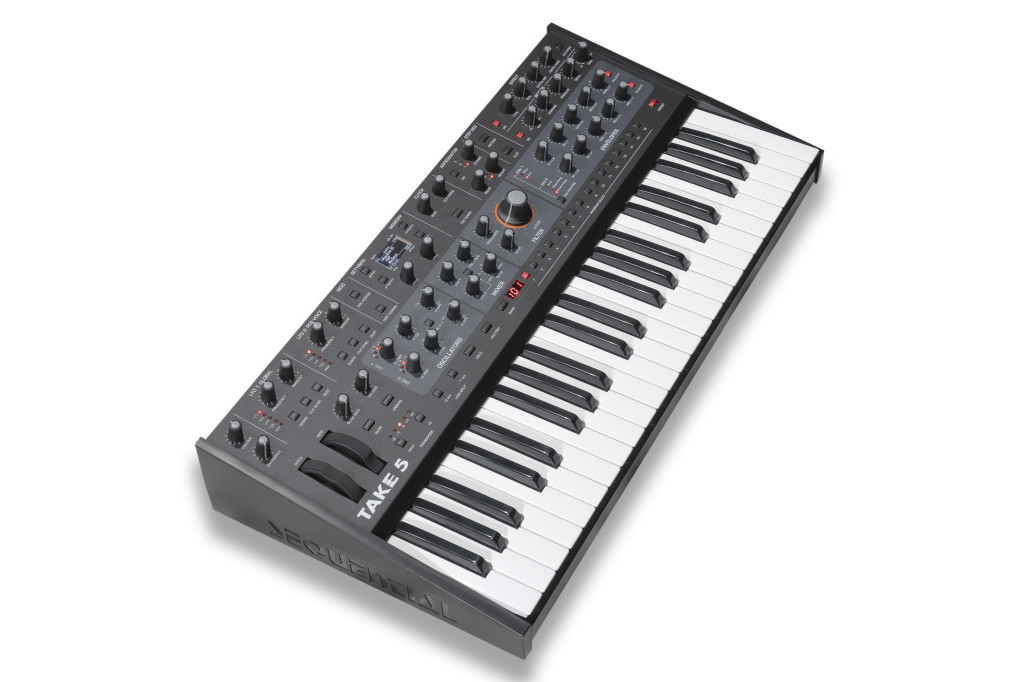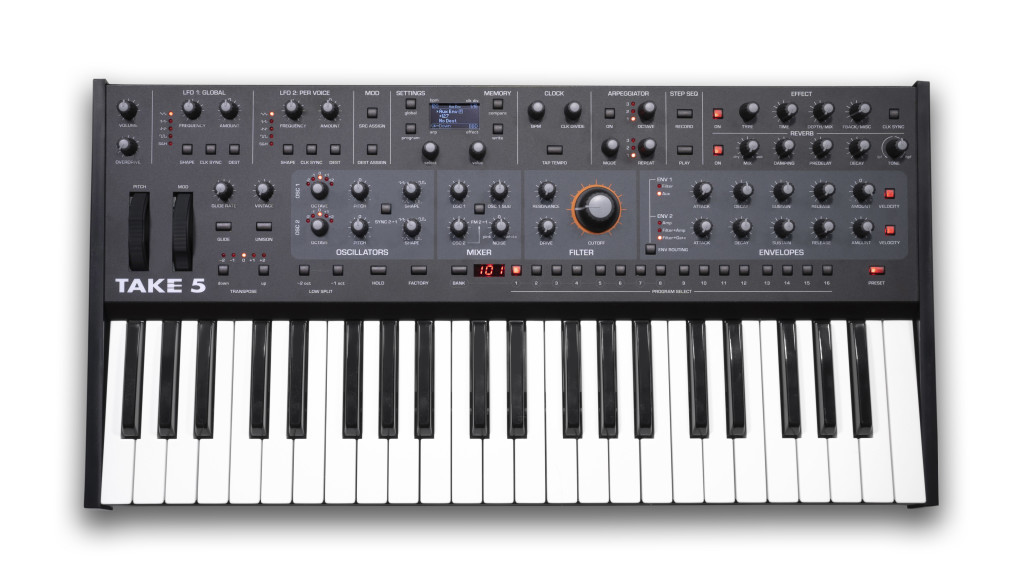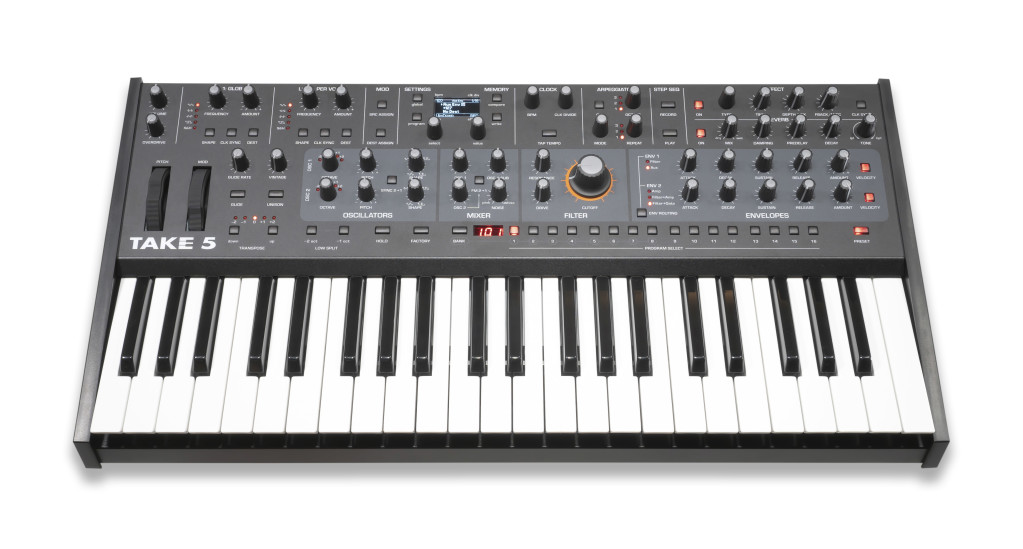It’s the Sequential polysynth for the rest of us – the same resonant analog filter as on the Prophet-5 Rev 4, plus a premium keybed and features, but a compact size and US$1299 price.
So yes, the Take 5 was leaked late last week. But now we have the full scoop from Sequential and Dave Smith, and – wow.

Short version: in Sequential’s crowded and tasty product range, this is a five-voice poly that brings together the most sought-after stuff, including that Prophet filter, in a size and price that’s easier to fit.
And it’s great to see that accessibility in the range, having been a fan of stuff like the Dave Smith Evolver that’s sitting next to me as I type this.
The specs are serious – yes, it’s a five-voice synth, but that doesn’t just mean it’s getting by on a “five-oscillator” technicality. This architecture is pretty thickly stacked for the price:

- Two VCOs and one sub-oscillator per voice
- 44 full-size keys (it’s a “premium” Fatar keybed, so they didn’t skimp there)
- Key split so you can set up two performance zones
- Dual digital effects
- Dedicated overdrive
- Continuously variable wave shaping
- Simple analog FM (frequency modulation) – also right on the front panel
- Prophet-5 rev4 4-pole analog filter, with Drive
- Vintage knob (for varying oscillator, filter, envelope behavior) – also the same as on the revised Prophet
- Two LFOs (1 global, 1 which you can assign to a voice)
- ADSR+delay envelopes
- 64-step polyphonic sequencer and multimode arpeggiator
The Prophet-5 remake, apart from reproducing all the wood and classic Prophet-5 look and functionality, does have the ability to switch to a Curtis filter, plus simple easy-access poly mod for modulation. But otherwise, I’d take (sorry) the Take 5, with more modulation options, arp, and sequencer. It’s really Prophet-5: The Next Generation, with a lower price and more-svelte size to match.
(To be clear – the filter is an SSI2140 low-pass filter from our friends at Sound Semiconductor, who derived this design directly from their SSM 2140 in the original Prophet-5 rev 1 + 2. On the rev4, you can swap between that and the Curtis filter. Either way, it’s great to see a direct lineage from the original chips. And they’re all nice folks.)
And the whole thing is just so cute. To be perfectly frank, I love this compact design with display more than the flagship Sequential stuff, just because it keeps stuff in easy reach and fits more easily on the go and in tight quarters. It still looks absolutely like a Sequential instrument – a proper 2021 take on what made us enjoy the Dave Smith renaissance in the first place.
There’s certainly still plenty to recommend Sequential’s Pro 3, Prophets, and OB-6. But it’s great that there’s now a mid-range synth this deep, complete with 3.5-octave keyboard. It’s got the key features – vintage knob and filter – that the Prophet reboot championed, without any sticker shock.
And I think the front-panel FM, easy zone splits, and all these controls and arp/sequencer will make this a terrific performance instrument. Plus it’s great to see dual digital effects, a DSI/Sequential hallmark, as well as enough overdrive and waveshaping to get dirty.
Sounds:
Product site:
This –
Full specs from Sequential below. It’s close enough to the Prophet-5 that you’d be forgiven for thinking I copied the wrong specs. In fact, you even gain a step sequencer/arp. Mainly what’s missing is the extra keys and a whole lot of extra weight, size, and wood, which is kind of a good thing for some of us – even as beautiful as the Prophet-5 looks:

OSCILLATORS
- Two analog VCOs per voice
- Continuously variable wave shape (sine, sawtooth, variable-width pulse) per oscillator
- Hard sync: oscillator 1 syncs to oscillator 2
- Square wave sub-octave generator (oscillator 1) per voice
- Keyboard tracking on/off for each oscillator
- Front-panel FM (frequency modulation)
MIXER
- Oscillator 1 amount
- Oscillator 1 sub-octave amount
- Oscillator 2 amount
- White noise amount
LOW-PASS FILTER
- Four-pole, resonant, analog low-pass filter per voice, based on Prophet 5 Rev 4 design
- Filter can be driven into self-oscillation with the Resonance control
- Bi-polar filter envelope amount
ENVELOPES
- Two 5-stage envelope generators (ADSR + delay) with variable routing (filter, amplifier, gate)
- Velocity modulation of each envelope amount
- Envelopes freely assignable to multiple modulation destinations
LOW FREQUENCY OSCILLATOR
- Five wave shapes: triangle, sawtooth, reverse sawtooth, square, and random (sample and hold)
- Clock sync (internal or external MIDI clock)
- Freely assignable to multiple modulation destinations
DIGITAL EFFECTS
- One dedicated reverb with damping, pre-delay, decay and tone
- One multi-effect with stereo delay, BBD delay, tape delay, chorus, flanger, phaser, ring mod, vintage rotating speaker, distortion, high-pass filter
- Dedicated Overdrive effect
VINTAGE KNOB
- Recreates the characteristics of vintage synthesizers by introducing micro-fluctuations in oscillators, filter, and envelopes per voice.
AFTERTOUCH
- Source: channel (mono) aftertouch with bi-polar amount
- Aftertouch freely assignable to multiple modulation destinations
CLOCK
- Master clock with tap tempo
- BPM control and display
- MIDI clock sync
ARPEGGIATOR
- Up, down, up+down, random, assign modes
- Syncs to MIDI clock
- Re-latching arpeggiation
SEQUENCER
- Polyphonic step sequencer with up to 64 steps with ties and rests
PERFORMANCE CONTROLS
- Full-sized, semi-weighted, 3.5-octave premium Fatar keyboard with velocity and aftertouch
- Spring-loaded pitch wheel with selectable range per program with independently adjustable upper and lower pitch wheel range transpose controls
- Low-split mode creates two independent performance zones with different octave ranges
- Hold switch latches held notes on
- Polyphonic glide (portamento)
- Unison (monophonic) mode with configurable voice count, from one to all five voices, and key modes
- Factory switch: when off, the front panel is live; what you see is what you hear
PATCH MEMORY
- 128 user and 128 factory
IN/OUT
- 1 MIDI In, 1 MIDI Out, and 1 MIDI Thru port
- USB port for bidirectional MIDI communication
- 1 Sustain/footswitch input
- 1 Expression pedal input
- Main stereo output (2 x 1/4″ phone jack)
- Headphone out (stereo 1/4″ phone jack)
POWER
- IEC AC power inlet for internal power supply
- Operates worldwide on voltages between 100 and 240 volts at 50 to 60 Hz; 14 watts maximum power consumption
PHYSICAL SPECS
- Premium, 3.5-octave, semi-weighted Fatar keyboard
- 25″ L x 12.75″ W x 4.4″ H (63.5 cm x 32.4 cm x 11.2 cm)
- Weight: 17 lbs (7.7 kg)
